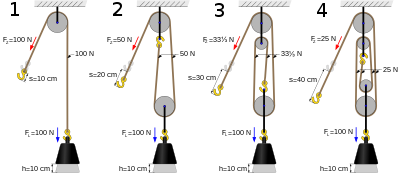Tackle
In the Seemannssprache a is Pulley as tackle and the bottle as a block designated; the rope used in the tackle is called a runner . The tackle has a fixed part , which denotes the end to which the runner is attached, and a loose or catching part. The word part is used here feminine (as feminine ).
One of the two blocks is usually equipped with a becket to attach the runner . (Picture below; No. 2, upper block, No. 3, lower block)
In order to be able to exert a tensile force on the fetching part, it is usually necessary to change its direction using a so-called guide block, a pulley .
As strategies or tackle is per block refers to a compound of cordage and blocks with more than three slices. This connection is used to lift particularly heavy loads. With a six- sheave cast with three sheaves per block, the power saving is 1: 6.
In mehrscheibigen tackles, a new runner in a specific order, the reeve , threaded, to achieve a uniform wear of the rolls and no twisting.
Dinghy rope
The dinghy rope is a rope that runs over a block, does not save energy and only serves to divert the direction of pull. It is not considered a tackle, but is related to it. (Fig. 1)
Folding runners
The folding runner is a simple tackle, as shown under 2 on the right. It is a small pulley system made up of two single-pane blocks.
literature
- Ulrich Scharnow among other things: Lexicon of seafaring. o 3rd edited and supplemented edition. Transpress Publishing House for Transport, Berlin 1981, p. 195.
photos
Gien on a boat davit



